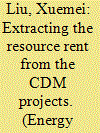| Srl | Item |
| 1 |
ID:
094277


|
|
|
|
|
| Publication |
2010.
|
| Summary/Abstract |
The revenue generated from a CDM project in China will be shared by the government and the project owner, and is also subject to the corporate income tax. This paper studies the impacts of the revenue sharing policy and income tax on the CDM market. The economic model presented in this paper shows that higher-cost CDM projects will be more affected by the CDM policies than lower-cost projects. In addition, the majority of CERs will be generated from lower-cost projects. This kind of distribution of CERs across different types of CDM projects, which is in line with the current picture of the CDM market in China, is not consistent with the goal of sustainable development. A simulation shows that a type-by-type tax/fee scheme would be more effective in assisting sustainable development than the current CDM policies. The study also suggests the government use negative tax/fee with the type-by-type scheme to subsidize the CDM projects that generate large sustainability benefits but would otherwise not be developed due to high costs. If all of the revenue from the CDM is recycled, it is estimated that CERs generation will increase by 98.28 MtC, mainly from the CDM projects that have substantial sustainability benefits for the host country.
|
|
|
|
|
|
|
|
|
|
|
|
|
|
|
|
| 2 |
ID:
099354


|
|
|
|
|
| Publication |
2010.
|
| Summary/Abstract |
Under the pressure of global warming, it is imperative for Chinese government to impose effective policy instruments to promote domestic energy saving and carbon emissions reduction. As one of the most important incentive-based policy instruments, carbon tax has sparked a lively controversy in China. This paper explores the impact of carbon tax on Chinese economy, as well as the cushion effects of the complementary policies, by constructing a dynamic recursive general equilibrium model. The model can describe the new equilibrium for each sequential independent period (e.g. one year) after carbon tax and the complementary policies are imposed, and thus describe the long-term impacts of the policies. The simulation results show that carbon tax is an effective policy tool because it can reduce carbon emissions with a little negative impact on economic growth; reducing indirect tax in the meantime of imposing carbon tax will help to reduce the negative impact of the tax on production and competitiveness; in addition, giving households subsidy in the meantime will help to stimulate household consumptions. Therefore, complementary policies used together with carbon tax will help to cushion the negative impacts of carbon tax on the economy. The dynamic CGE analysis shows the impact of carbon tax policy on the GDP is relatively small, but the reduction of carbon emission is relatively large.
|
|
|
|
|
|
|
|
|
|
|
|
|
|
|
|
| 3 |
ID:
126483


|
|
|
|
|
| Publication |
2013.
|
| Summary/Abstract |
China's wind power capacity has increased dramatically in recent years, but about 30% of the installed capacity sits idle, so overinvestment in wind power capacity seems to be a serious problem. This paper explores reasons for the overinvestment. The economic analysis shows that, given uncertain future policy on wind power, it is optimal for power companies to invest more than the amount in a certain world. A part of the "overinvestment" has a real value, which can be interpreted as the value of holding scarce wind resource. This value exists because the wind-rich sites with convenient locations to connect to the grids are scarce resource, and also because the specific government policies that are essential for promoting wind power are uncertain in the future. This value should be taken into account in the investment decision, but it results in the phenomenon of "overinvestment". The concept of the value of holding scarce resource can be generally applied to the resources that are scarce and for which the future policy is uncertain.
|
|
|
|
|
|
|
|
|
|
|
|
|
|
|
|